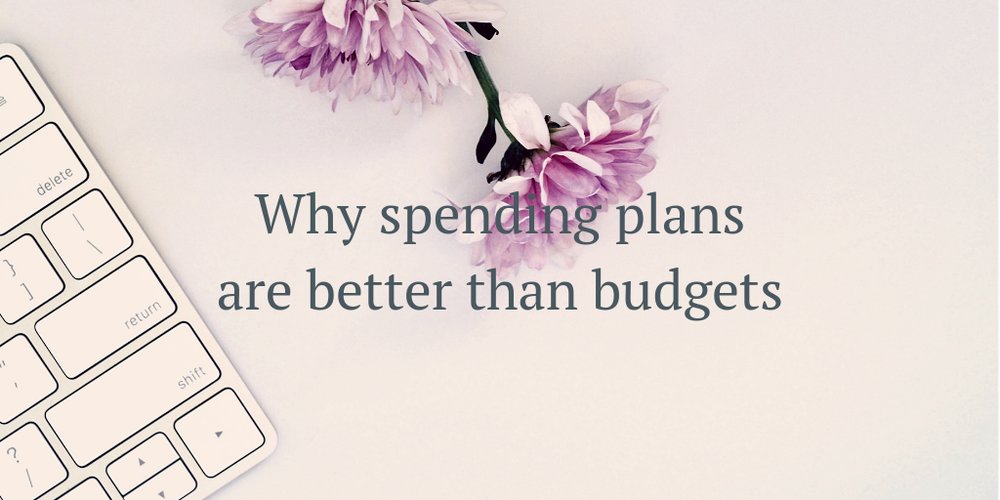
Do you cringe when you hear the word “budget”? For many people a budget means restrictions, scarcity and a spoiler to having fun.
Our brain reacts to the word “budget” in the same way it reacts to the word “diet”. Rather than thinking about what you want, you’re constantly thinking about what you can’t have. We may get motivated enough to start but after a while we feel deprived and it sucks the joy out of life. Is it any wonder we have trouble sticking with it?
Now, I know that budgets work for some people, but not for me.
I grew up using the envelope system where you start with weekly income and average your expenses down to the same frequency. I would allocate weekly amounts for all of our expenses to each “envelope” (e.g., mortgage, food, fuel, telephone, electricity, insurances, car registration, etc.).
I felt like I was constantly micromanaging all of these different buckets of money and lived in hope that the funds would be there when each bill was due.
I was always anxious about spending and when I did run out of money in a particular category, I’d beat myself up for not managing things better.
Things got even more complicated once my husband started his business. The income from the business was unpredictable and seasonal with high income in the summer and very little in winter.
We often had to resort to credit cards to get us through the winter months and spent the summer in catch-up mode. It took all my effort just to keep our heads above water and there was never any money left for savings.
Family holidays were something that we could only dream about and I became frustrated that we may never pay out our mortgage.
Budgeting and tracking every cent was exhausting and it wasn’t working anyway.
So, I went in search of an alternative and discovered spending plans and a clever piece of software that took the guesswork and stress out of managing our finances. This was life-changing for us.
You can read more about my journey with spending plans here.
How is a spending plan different to a budget?
1. Start with expenses, not income
If you start with income and divide it up, the outcome will always be no money left over. This is the case no matter how much you earn.
Let’s face it, there are people who earn less than you who are in better financial shape. There are also those on high incomes who are struggling financially. It’s not about income!
Budgets begin with your income and you try to fit everything into how much you earn.
A budget compares “ins” with “outs” and hopefully shows you that it’s possible to pay your expenses but it doesn’t show you how to do it.
When you budget for expenses in this way there’ll be times when bills arrive that you’ll be short on the amount required. For example, you start budgeting a weekly amount for car registration in January and the bill arrives in August. It simply doesn’t work unless you have a stash of money to fall back on (unlikely for most of us).
A spending plan focuses on what needs to go out and not how to spend what comes in.
You start with your financial commitments, goals and priorities. Your spending plan lays your income and expenses onto a timeline and tells you what your absolute lowest safe account balance is for each day for the next year in advance. It makes it possible to see how to make all those payments and purchases on time every time!
2. Look to the future, not the past
Budgeting systems that require you to enter and maintain historical financial data to show you what happened in the past won’t change your future.
Keeping detailed records of your spending isn’t going to keep you on track. It’s the same as trying to drive while constantly watching in the rearview mirror. By the time you realise you’ve overspent (you’re going to crash) it’s too late to do anything about it. This used to happen to me all the time!
We make spending decisions every day and it’s easy to check our account balances online. But knowing your bank balance doesn’t help you with questions like, “I wonder if I have some spare money right now?” or “I wonder if I’m headed for a financial crisis?”
A spending plan shows the daily minimum targets you must hit. So, if your spending plan says you must have $360 and you have $400 in your bank account you can choose to spend $40 free of guilt or shame!
Looking into the future with a spending plan also allows you to see problems ahead and take preventative action BEFORE the problem hits.
A spending plan is like a GPS to get you where you want to go. You can be confident that you’ll achieve the savings and debt reduction goals built into your plan and easily manage your money day-to-day. A spending plan also gives you the flexibility to revise your plan to account for major life events such as starting a family, job loss or illness.
3. Remove the guesswork
Budgets require you to make the right choices based on self-discipline. For most people this doesn’t work and leads to resentment and feelings of failure.
When you rely on your feelings or the fact that you have no money in the bank to dictate when, or if, you spend money, you’re guessing and hoping for the best.
A spending plan removes the need for self-discipline and guesswork because you know in advance the amount you should have in your bank account today, tomorrow, the next day and beyond based on the expenses you planned for in advance. When your account balance is above target, you can choose to spend any surplus however you wish without jeopardising your financial health.
4. Systemise your spending
We all know there are some things in life you have no control over. BUT what most people don’t realise is that many expenses are predictable and controllable if they simply just take control of them!
If you’re budgeting and looking backwards (see no. 2) you are merely reminiscing and guessing.
Most people’s cost of living is determined by their income. The spending plan system clearly isolates the cost of living from income. It not only shows you what it costs to pay your expenses, but how to pay them.
This is a game-changer for entrepreneurs who need to know precisely how much revenue their business needs to make to fund their lifestyle.
Most of my clients also have a spending plan for their business. It’s the perfect system to manage business expenses, cash flow and inconsistent income.
5. Measure your success
Budgets fall short because we can’t see clearly what success or failure looks like. It’s hard to make good financial decisions if you don’t know whether or not you are on track, ahead or behind.
A spending plan gives you daily targets to hit making it easy to track your progress and reward yourself for success.
6. Allow for longer term needs
Budgets are inadequate when it comes to allowing for expenses that occur every so many years. Let’s say you include $2 a week in your budget to replace your refrigerator every 10 years.
There’s very little likelihood of that money being available when you need it because you’re relying on willpower to prevent you from spending the money on something else.
When you create a spending plan you look at the possessions that support your life and put a plan in place so that the money is there when each of those items reaches a certain age. When the date rolls around the money is available to replace the item painlessly.
7. Save time
Let’s be honest, budgets are time-consuming and boring. Most of us are too busy to create one, much less stick with it. I got fed up with inputting data into spreadsheets. I felt like I was wasting precious time that could be spent doing other more productive or joyful things.
A spending plan does take time to set up, but you only do this once. All you need is a few minutes a week to check yourself against your targets. Easy!
8. The right mindset
Another difference between budgets and spending plans is that budgets are reactive which seems to encourage a lack of control. I always felt as if my money had control of me and there was never enough.
A spending plan gives me the feeling of spending my money purposefully. It allows you to say, “I’ve taken charge of my finances and I’m choosing to direct my money so it supports my most important priorities”.
It’s a subtle shift but it puts you squarely in the driver’s seat of your financial destiny which is very liberating.
9. Get your partner on board
As with most relationships, my partner and I have different money personalities and ideas about how money should be managed.
Budgeting often causes fights and this can be a recipe for disaster unless the couple can work out a compromise.
By creating a spending plan together couples can plainly see that their individual needs and wants are being met as far as possible. The overall bigger plan decided in collaboration together gives both parties joint ownership of their spending plan.
What do you think?
Still not convinced? A spending plan can help you get your financial situation under control and replace fear with optimism.
Once you do that, you’ll have more time to do the things that you love. What’s more, you’ll truly be able to enjoy that massage, holiday or new car if you’re not stressed and worried about money.
I’d love to know what you think. Let me know in the comments.
If you want to know more about how I can help you get off the money roller coaster and open up a brighter financial future, I’d love to talk. Book in for a free chat with me here.

